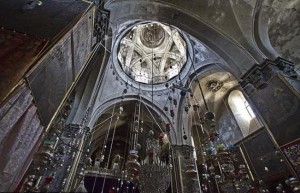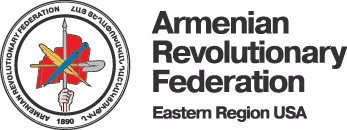In Jerusalem Quarter, Armenians Fear for Future

The Armenian presence in the Holy Land predates the life of Jesus Christ, when Armenia and Palestine were part of a common empire. The Armenian Great King Tigran II (95 to 55 BC) conquered the northern part and extended his influence over Palestine. Ever since Armenia became the first nation to adopt Christianity as its official state religion (301 AD), the Armenians have contributed to the diverse mosaic of peoples in the Holy Land. Armenian pilgrims began traveling to Jerusalem, and some remained to establish a permanent community.
The place of Jerusalem in the process of seeking peace in the Middle East is unique. Its historical, emotional, and international complexities set it apart from other issues which may be solved on the basis of mutually agreed boundaries. The questions that the Arabs raise about Jerusalem cannot be decided by drawing a line. The future of Jerusalem cannot be resolved by division.
This does not mean that Jerusalem is “an insoluble problem.” It means that Jerusalem’s people of differing faiths, cultures, and aspirations must find peaceful ways to live together. It is no solution to again build concrete walls and put up barbed wire through the middle of the city.
The problem of Jerusalem is difficult because age-old and deeply felt emotions are encrusted over the rationality necessary to find solutions. But I am convinced that these solutions can be found by people of good will.
Jerusalem is, of course, one of the oldest cities. Signs of human habitation have been found there dating back at least 4,000 years. In the course of these millennia it has been coveted and conquered by a host of peoples: Canaanites, Jebusites, Jews, Babylonians, Assyrians, Persians, Romans, Byzantines, Arabs, Crusaders, Mamelukes, Ottomans, British, and Jews. But throughout those thousands of years, Jerusalem has been divided for less than two decades: from 1948 to 1967. It must never again be divided. To cut this living city in two once more would be as cruel as it is irrational.
The rare sense of space and calm that marks out the Armenian Quarter of Jerusalem’s Old City is both its blessing and its curse. The acquisition of the land, and construction of the beautiful St. James Cathedral at its heart, speaks volumes of the abilities of this small ethnic diaspora from the Caucasus to secure favor from the Ottoman sultans who partitioned the walled holy city in the hope of a bit of peace from religious rivalries.
But the limited and shrinking population of the Armenians has made their Quarter an object of envy and desire for other groups, not least the fast-expanding Jewish Quarter next door, which has been massively rebuilt during 43 years of Israeli control after being ravaged during the period of Jordanian rule from 1948-67.
The Armenian Church itself, proud of the tradition that it was an Armenian king in 301AD who first adopted Christianity as a state religion (some years before the Roman Empire), is a solid fixture of Christian Jerusalem. The small ethnic Armenian community around it, however, feels less sure of its future.
Having broken with authorities in Constantinople and Rome as early as the 6th century (in a complex dispute over the human and divine nature of Jesus), the Armenian Church later secured—under the Ottoman-era status quo that still governs such matters—a share of the tripartite governance of Jerusalem’s Christian holy sites, notably the Church of the Holy Sepulchre, with the much larger Eastern Orthodox and Roman Catholic denominations. The latter churches and a small community of their Arab Christian adherents dominate the Christian Quarter, leaving the Armenians in splendid, if potentially precarious, isolation in their own Quarter, following their distinctive traditions in their unfamiliar Indo-European tongue with its unique script.
Among the challenges facing the Armenians and the also-dwindling populations of the other Christian denominations is ensuring cooperation while retaining their distinct traditions. Inter-marriage among different Christian groups is seen by many as a welcome and inevitable way to maintain the communities, but it also poses problems for those keen to maintain linguistic, religious, and other differences.
Tensions, too, are frequent, not just with Jewish and Muslim populations in Jerusalem, but also within the holiest places of Christendom themselves. While the rich diversity of Christian worship in the city is a joy to many, scenes of armed Israeli police and troops having to pull rival priests, notably Greeks and Armenians, off each other within feet of Jesus’ tomb in recent years have done little to burnish the kind of ecumenism many church leaders preach.
Stability in the region is scarce and business opportunities are few, so the lure of emigration continues to haunt our lives. In order to stay in this region, Armenians and Palestinians must maintain their belief that the present conflict in the Holy Land will pass and that their richly diverse communities will continue to exist.
The story of the Armenians of Jerusalem is a fascinating tale of courage, hope, and endurance, sprinkled with the inevitable grains of turmoil and tragedy.
Source: Armenian Weekly Mid-West

